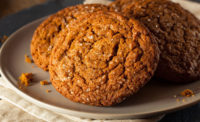Grains are a fundamental ingredient for snack and bakery products. They provide taste, texture, nutritional, and functional benefits. Consumers have a growing interest in wholesome plant-based foods and ingredients and according to the 2021 IFIC “Health and Food” survey, three of the top four nutrients people are trying to consume in their diet are proteins, fiber, and whole grains.
Multiple benefits
According to ADM, Chicago, health-conscious consumers expect more from snack and bakery products; they’re looking for nourishment, comfort, emotional well-being, and indulgence. “Specifically, health benefits and extra protein are two of the top five reasons consumers are seeking out snacks today. With wholesome, plant-based ingredients like ancient grains, beans, pulses, nuts and seeds, bakers can address both nutritional and sensory demands to deliver consumer-preferred products. Wholesome ingredients can add visual appeal, crunchy texture, label-friendly qualities, and plant-based nutrition with added fiber and protein, as well as intriguing flavors. Plus soy, pea, and wheat proteins along with flax and chia seeds and powders provide functional attributes to aid in binding and emulsification in snack and bakery formulations,” explains John Powers, marketing director, snacking and baked goods.
Since beans are a better-for-you ingredient that is seeing accelerated growth in snacks, the company has developed a variety of savory chips that include navy beans, black beans, or plant protein blends that have higher protein and fiber labels versus traditional tortilla chips. The company also created a nacho cheese chip made with seven plant proteins including navy beans, quinoa, brown rice, hemp, chia, sunflower, and flax seeds. Not only do these plant-forward chips forward exceptional crunch and flavor they are also non-GMO, vegetarian, and gluten-free.
Cam Suárez-Bitár, director of marketing and public relations, Bellarise, Pasadena, CA shares ways to incorporate whole grains, ancient grains, and pseudo grains into snack and bakery applications to add texture, nutrition, and functionality to the products:
-
Whole grains offer unique combinations of nutrients and are a good source of fiber. When sprouted, those nutrients become more bioavailable and easier for the human body to process. Whole grains have a more beneficial glycemic index, which allows the human body to digest them more slowly. They may also be used by bakers to enrich the bread’s texture.
-
Ancient grains may be soaked and used in dough to strengthen a bread’s gluten matrix, then added on top to add texture. They may also add toasted flavor notes and other nuances when baked into a bread, thereby contributing to a special sensory experience.
-
Pseudo grains like amaranth and quinoa offer multiple benefits. Amaranth is rich in fiber, protein, antioxidants, and other nutrients, such as magnesium and calcium. Quinoa provides a broad range of nutritional benefits, such as being a source of protein, fiber, amino acids, manganese, and B vitamins, among other nutrients. With crunchy seeds like amaranth and quinoa, bakers may also enrich their breads’ texture, thereby giving bread lovers more ways to enjoy their favorite baked goods. Examples of other snack and bakery applications where amaranth can be used to enhance the nutritional value and texture include: breakfast bars, power bars, breads, puddings, and even falafel. Quinoa, which is actually a seed, is perfect for use in many diets, including gluten-free regimens.
According to Michael Gleason, product manager, bakery, Puratos USA, Pennsauken, NJ: “Multigrain solutions and products that call out trending health benefits including immune health have seen the biggest increase in demand activity. And 79 percent of global consumers rate grains and seeds as the top contributor to health benefits in breads. Seeds have historically played an important role in human health and nutrition with macro and micronutrients that contribute to growth, energy provisions and other body functions. Seeds are also a great source of fiber, something 9 out of 10 consumers do not get enough of.” Seeds can be used to bring interesting flavors and textures to breads and pastries.
Innovative grains
Vanessa Brovelli, senior manager R&D, Bay State Milling, Quincy, MA, says the company has seen demand for oats increase across the board, with the oat market growing globally at nearly 5 percent year over year. A relatively new product Bay State Milling’s SowNaked Oats are a unique, non-GMO variety of oats which naturally contain 40 percent more protein as compared with traditional oats. The product combines both the wholesome, heart healthy goodness of oats with the muscle-building power of protein. “The species of oats we grow is called Avena nuda (literally naked oats). It’s a unique cultivar that naturally sheds itself of the outer hull during harvest so there is no need for the dehulling process. Because SowNaked Oats naturally lack hulls, they can be processed more sustainably with significantly less energy—resulting in a 50 percent reduction in SowNaked Oat’s carbon footprint when compared to traditional oats.” The product imparts a distinctive nutty, slightly toasted, sweet flavor. The naked oats flakes and groats can used in a broad range of applications including bars, cereals, granola and clusters. Oat flour can be used in gluten-free baked goods such as muffins, cookies and griddle mixes. The crop is grown in the U.S., mainly in Montana, under strict, gluten-free purity protocol standards.
Puratos has seen an increased interest in consumers looking for healthy, flavorful ways to incorporate more whole grain into their diet. To address this growing interest, the company recently launched Sapore Leo, a 100 percent liquid whole wheat, organic sourdough. “This latest innovation can be added to a wide range of breads, and its mild sour flavor helps bakers create amazing whole wheat breads without the bitter taste often associated with whole grain products. However to stand out on a shelf, healthy breads must also showcase that they support trending functionalities. For example, 72 percent of people are interested in food that improves gut health. As a 100 percent whole wheat sourdough, Sapore Leo helps achieve whole wheat and fiber claims associated with a happy and healthy gut,” explains Gleason.
After 20 years of research, Limagrain Ingredients is proud to introduce LifyWheat, a unique and pioneering wheat ingredient. LifyWheat is the result of “crossbreeding between the variety selected for its amylose-rich character and a complementary variety with agronomic and applicative functionalities which gives this wheat its health benefits. LifyWheat white flour contains 10 times more fiber than common white wheat flour, 25 percent fiber as compared to 2.5 percent in a standard wheat,” explains Anne Lionnet, business developer at Limagrain Ingredients, Weert, the Netherlands, in charge of LifyWheat’s European development. She goes on to highlight what makes LifyWheat so different:
- 80 percent of the fiber in LifyWheat is resistant starch. LifyWheat can easily increase and diversify fiber consumption. Its richness in resistant starch confers health benefits to the wheat.
- Resistant starch is naturally present in the wheat grain, it is not extracted and processed.
-
LifyWheat flour can be used in a wide range of applications that fit into consumer daily diet: bread, pasta, biscuits, breakfast cereal. It can be incorporated as a partial or total replacement for the wheat flour or wheat grains without any major change in the process. This flour increases fiber intake without changing eating habits compared to a traditional white flour. It offers the same taste and the same white color as traditional flour with the ability to naturally enrich products with fiber.
Benexia, Santiago, Chile, recently relaunched its chai flour designed for baking applications, Benexia Xia Powder 435 LM. Remi Reguero, technical director, describes the nutritional and functional benefits, and which applications this newly relaunched ingredient is best suited for:
Nutritional:
-
Contains 56 percent fiber (10 percent soluble and 90 percent fermentable insoluble fiber) and zero available carbs.
-
Contains 25 percent protein of high biological value and has a complete amino acid profile.
-
Has 5 percent omega-3 ALA, is highly stable to the baking and extrusion process, and provides a great clean taste.
-
Offers vital minerals such as calcium, magnesium, phosphorous, and potassium.
-
Is low in sodium and sugar.
Functional:
-
It provides tremendous water absorption capability, improving ingredient binding due to its small standardized particle size.
-
It can help formulators reduce or eliminate additives or undesired ingredients in a baking formulation and provide a cleaner label.
-
The soluble fiber content, about 5.6 percent, allows it to absorb and bind water up to 9 times its weight and minimizes the water migration in the baking product It increases the softness of the product texture during a more extended period, increasing the product sensorial shelf life.
Applications:
-
Breads: gluten-free, keto, artisan, whole grain, and seed.
-
Baking: Excellent for tortillas, flatbreads, and wraps or even pancakes and crepes, especially for low-carb and gluten-free applications.
-
Baked snacks: Excellent ingredient for cookies, muffins, cakes, sponge cakes.
The supply chain
With ingredient and supply chain shortages, businesses are scrambling to find solutions and minimize the impact to their business. Bellarise offers a custom enzyme-based line of its Gluten Replacer systems that can help industrial and commercial bakeries address potential shortages in vital wheat gluten or organic vital wheat gluten by reducing costs and increasing baker’s control over the quality of the bread. “In addition to lowering the costs and use rates of vital wheat gluten, our line of clean label and organic Bellarise Gluten Replacers consists of enzyme-based dough conditioners that help achieve the best texture, volume, crumb structure, proof, and overall quality of the breads that require either conventional or organic vital wheat gluten,” explains Suárez-Bitár. The entire line is clean label, non-GMO, kosher, and includes an organic version.
In the event of a supply chain shortage it is important to know what each grain ingredient contributes to the formula, including the impact on nutrition, flavor and performance. “For example, amaranth and quinoa are known to have similar protein contribution and water holding capacity, thus nutrition label or dough rheology may not change with a switch between the two, however their flavors are fairly different. Identifying the unique attributes of each grain is crucial to be able to create the ideal replacement grain blend if supply issues arise. The company uses a holistic assessment framework, ‘Jobs To Be Done,’ as a tool to understand and quantify the benefits and tradeoffs of replacing certain ingredients, taking into consideration not just sensory, functional and nutritional changes but also economic, production and marketing/labeling implications,” explains Brovelli.
To overcome potential shortage on vital wheat gluten, Puratos offer Intens Tolerance for use in direct method and frozen dough. “This is an ingredient that strengthens dough and improves its tolerance by optimizing gluten development and strengthening the gluten network. This gives an improved and more consistent volume in the end product,” shares Gleason. Intens Tolerance can be used in a wide range of bakery products including: bagels, baguettes, ciabattas, flat bread, flour tortillas, hamburger buns, loaf breads, multi-grain wholemeal breads, pizza, pretzels, rolls, rye bread, soft rolls, toast bread, and yeast-raised doughnuts.






